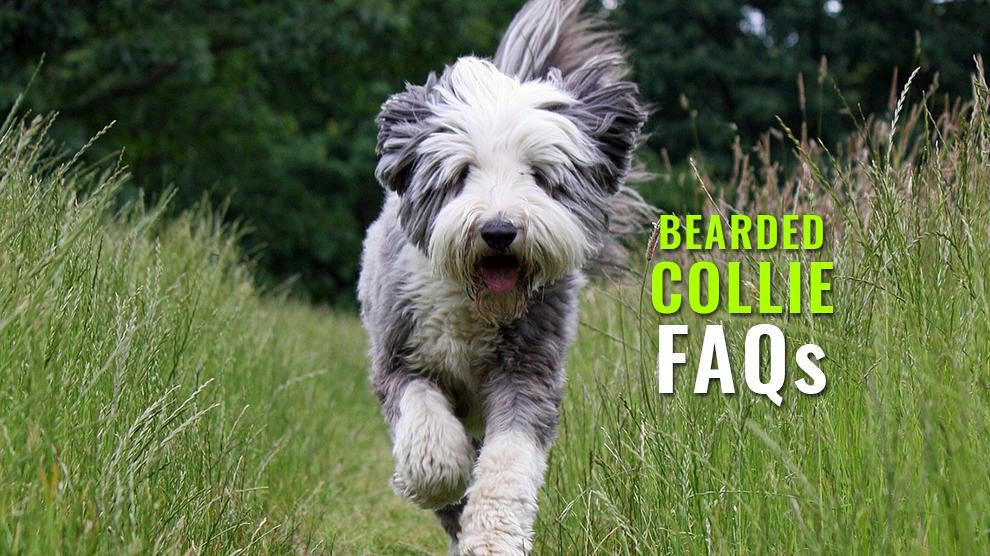What Does A Bearded Collie Look Like?
Bearded collies have a broad head, short muzzles and a level topline with shaggy coats and perpetually wagging tails.
The ears droop down and have a long hair fringe. They boast a smart expression and the arched eyebrows add to their overall charming looks.
Their beard covers some of the muzzles. The long flowing coat is in fact, a double coat with a furry and soft undercoat and a coarser and very shaggy outer coat.
Beardies may be black (from black to slate), brown (from milk or dark chocolate to gingery red), blue (from steel blue to silver) or fawn (champagne to cinnamon), typically with white markings to a larger or lesser degree.
Do Bearded Collie Dogs Shed?
Like all other breeds, the bearded collie tends to shed once in a year and mostly during the spring and then again in the autumn when more frequent brushing is needed to keep on top of things.
When grooming properly, they shed minimally. Most of the dead hair will be removed by the grooming.
Usually, between nine months and eighteen months, they lose their puppy coat and that is their worst shed which may last for approximately two to three months.
During the ‘puppy shed period’, they often lose their cuddly appearance and look ragged and scraggly, losing hair from the front to the rear or from the top to the bottom.
Are Bearded Collies Hypoallergenic?
Yes. But, at the outset, it’s important to understand that no dog is 100% non-allergenic.
However, some dogs can be considered hypoallergenic (“low-allergy”), meaning they are less likely to cause an allergic reaction than other dogs.
That doesn’t mean they won’t cause an allergic reaction at all, but, perhaps, they produce fewer allergens and thusly an allergic person will tolerate them better.
Whether or not you have an allergic reaction to a hypoallergenic dog depends on the severity of allergies you have.
People with very high sensitivity/ severe allergies to dander up may still not be able to tolerate a hypoallergenic dog. Bearded Collie is considered to be hypoallergenic and its hair pH is the same as that of the human hair.
However, the AKC doesn’t list Beardies among its breeds recommended for allergy sufferers.
Where Did The Bearded Collie Originate From?
One of the oldest herding breeds, the bearded collie is thought to be descended from some Polish lowland sheepdogs (Polski Owzcarek Nizinny) left by the invading armies in Scotland in the 16th century.
These dogs then bred with the native herding dogs to produce these herding dogs of the British Isles.
Beardies were highly cherished by farmers and herdsmen in Scotland, in the north of England and some parts of Wales for their herding skills and were called Highland Collies or Mountain Collies.
Are Bearded Collies Good Family Dogs?
Beardies are family-oriented dogs. They love to be with their family. If left alone for long periods, they become restless and damage their own entertainment – which may not make the pet parent happy.
Beardies are loud, bouncy dogs, and like to hop to look you in the eyes or kiss your cheeks.
Others, particularly those with elderly persons, toddlers physically challenged people or non-doggy visitors, wish to train their Beardie to sit and shake hands rather than jumping on people to greet them.
As they love people, Beardies make good therapy dogs, comforting, cuddling and entertaining the residents and patients.
Are Bearded Collies Good With Kids?
Beardies are generally good around kids of all ages. However, it’s always a good idea to keep an eye on “playtime” which can get a bit rude at times.
Beardies have a high herding instinct and their tendency toward “ruff” play means you’ll want to supervise them when they are with your little ones.
When they are too active, they may nip at ankles or eye-level bottoms of kids, trying to bunch their “flock.”
If the undesirable traits are “nipped” in the bud and the baby Beardie energies are channeled into proper behavior, they fit in well with families and with kids.











